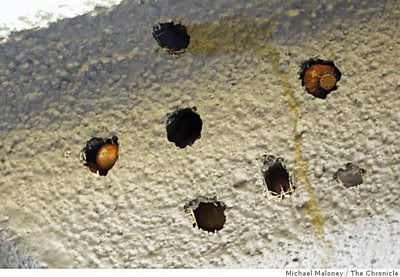
Are woodpeckers pecking holes in your wood or stucco? Do you have so many holes in your siding that smaller birds have started to nest in abandoned woodpecker holes? Without effective and humane bird deterrents, your home will be at the mercy of woodpeckers. Can you afford the expense of re-siding your home right now?
One homeowner had woodpeckers eating through the mahogany siding covering her home. But when she filled in the holes and the house was repainted, the woodpeckers came back as soon as the painters left. One woodpecker put its head into the hole it had made and yanked insulation right out of the wall. Woodpeckers have been known to peck away at siding and tear out the insulation to make a hole suitable for nesting.Another homeowner had woodpeckers pecking right through her wood siding and through the plywood underneath. The birds promptly tore the insulation out and built a nest between the wallboard and plywood. She put tin over the holes, but the birds just pecked a new hole next to the tin. She plans on putting vinyl siding over the wood, but believes they may peck through that as well. A consultation with a bird control expert would be a smart first move.Contrary to common belief, woodpeckers aren’t looking for bugs when they peck holes in your siding. Experts suggest that woodpeckers seek bugs in your boards less than 10 percent of the time. And the bugs they’re looking for are usually harmless to your wood or siding.Getting rid of woodpeckers can be a challenge—unless you use professional bird control methods. Shooting them, destroying their nests, or using poisons are cruel methods that may be illegal. Woodpeckers are protected in most states, so these methods are ill advised. Here are some woodpecker deterrents the pros recommend:Woodpecker Deterrent KitsTo get rid of woodpeckers, get a Wood Pecker Deterrent Kit. They come with a Bird Repeller Balloon, a 50-foot roll of Flash Tape, and all the hardware you need to hang them up. Flash Tape Banners crinkle in the breeze and reflect sunlight, which will scare most birds away. Bird Repeller Balloons are covered with a big “predator eye.” The balloons bob and weave in the wind and convince birds that a giant predator is ogling them. To ensure woodpeckers don’t get used to these “threats,” your should move them around frequently. Lightweight Plastic Bird NettingBy physically blocking out birds from your siding, Lightweight Plastic Bird Netting denies woodpeckers access to it. Bird netting comes in several mesh sizes. For woodpeckers, get 3/4-inch mesh netting. You can also get bird netting in a variety of colors to match your home's exterior. To keep woodpeckers away, install the netting in overhanging eaves or other nooks and crannies where woodpeckers peck.

